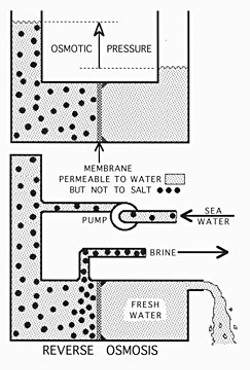[
{
"name": "Top Stories Video Pair",
"insertPoint": "7",
"component": "17087298",
"parentWrapperClass": "fdn-ads-inline-content-block",
"requiredCountToDisplay": "1"
}
]
Sap drips from the leaves of my indoor banana plant. Osmosis is the process that raises that sap against gravity. Osmosis causes our kidneys to retain more water in our blood after a salty meal. Reverse Osmosis (RO) is the preferred method for producing fresh water from ocean water. The U.S. is second only to Saudi Arabia in desalinating sea water. Clearly, osmosis is a critical process for plants and animals, as well as contributing to domestic water supplies. Furthermore, osmosis is a potential source of renewable energy for our North Coast.
When pure water and saline water are on opposite sides of a membrane permeable only to water, the water will diffuse into the saline side and establish a pressure difference. Pressure is caused by molecules bouncing off the membrane. At equilibrium, equal numbers of water molecules pass through in opposite directions and equal numbers bounce off opposite sides of the membrane, so the pressures due solely to water are equalized. However, dissolved molecules or ions, too big or charged to pass through the membrane, also produce pressure. The sum of solvent and solute pressure on one side is greater than the pressure of pure solvent on the other.
The osmotic pressure of sea water is 24 atmospheres, so the left column in the diagram would be 240 meters taller. RO plants pump sea water to at least twice that pressure. To save energy, pumping is assisted by the pressure of discarded brine.
While southern California expends energy in squeezing fresh water out of sea water, we could generate energy by doing the opposite: We could diffuse river water into sea water through membranes and then direct the osmotically pressurized sea water through turbines. Norway's prototype system is under construction.
In light of the amazing pressures produced by osmosis, one has to admire the ability of anadromous fish to survive in both fresh and marine waters at different stages of their lives.
Theory: Dissolved molecules within a volume (V) behave like gas molecules in producing pressure (P): PV=nRT, where n is proportional to the number of molecules, R is the Gas Constant and T is in Kelvins. As n/V is equivalent to "Moles per liter" (M), we see that P=iMRT, where i corrects for the dissociation of salts into ions.
more from the author
-
Nuclear Matters
- May 6, 2010
-
Sophie Smells a Shaker
- Feb 4, 2010
-
The Roots of Love
- Feb 5, 2009
- More »
































